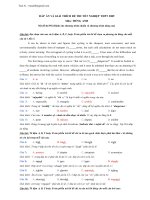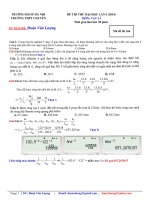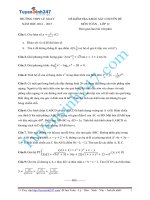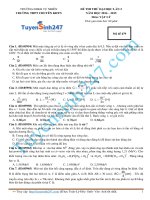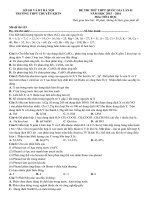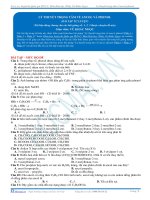dap an va loi giai de tot nghiep 2009
Bạn đang xem bản rút gọn của tài liệu. Xem và tải ngay bản đầy đủ của tài liệu tại đây (204.34 KB, 6 trang )
Tran Ai –
ĐÁP ÁN VÀ GIẢI THÍCH ĐỀ THI TỐT NGHIỆP THPT
2009
Môn: TIẾNG
ANH
Mã đề thi 952 (Dành cho chương trình chuẩn và chương trình nâng
cao)
Câu h ỏ i: Đọc đoạn văn sau và tô đậm A, B, C, hoặc D vào phiếu trả lời để chọn ra phương án đúng cho
mỗi
câu từ 1 đến
5.
It can be shown in facts and figures that cycling is the cheapest, most convenient, and
most
environmentally desirable form of transport (1)_ towns, but such cold calculations do not mean much
on
a
frosty winter morning. The real appeal of cycling is that it is so (2)_ . It has none of the difficulties
and
tensions of other ways of travelling so you are more cheerful after a ride, even through the rush
hour.
The first thing a non-cyclist says to you is: “But isn’t it (3) dangerous?” It would be foolish
to
deny the danger of sharing the road with motor vehicles and it must be admitted that there are an alarming
(4)
of accidents involving cyclists. However , although police records (5) that the car driver is
often
to
blame, the answer lies with the cyclist. It is possible to ride in such a way as to reduce risks to a
minimum.
Câu 1: A. in B. at C. to
D.
on
Giải thích: Giới từ “in” đi với danh từ “towns” mang nghĩa là “trong các thành ph ố”. Các giới từ còn lại
đi
với danh từ này đều không
h
ợp nghĩa với ngữ
cảnh.
Câu 2: A. boring B. careful C. enjoyable D.
excited
Giải thích: “enjoyable” có nghĩa là “thú
v
ị” là hợp lí nhất về nghĩa trong câu
này.
Câu 3: A. expectedly B. strangely C. terribly D.
comfortably
Giải thích: Trạng từ “terribly” chỉ mức độ có nghĩa là “rất”, dùng để bổ nghĩa cho tính
t
ừ
“dangerous”.
Câu 4: A. size B. number C. deal D.
digit
Giải thích: Cấu trúc: A number of + danh từ đếm được số nhiều. Vì vậy đáp án đúng là
B.
Câu 5: A. point B. indicate C. display D.
exhibit
Giải thích: Động từ mang
ngh
ĩa phù
h
ợp nhất là indicate (indicate that + mệnh đề: chỉ ra rằng). Vậy B là
đáp
án
đúng.
Câu h ỏ i: Tô đậm A, B, C hoặc D vào phiếu trả lời để chỉ ra từ nào gạch chân được phát âm khác
v
ới
những
từ còn lại trong mỗi câu
sau.
Câu 6: A. hig h B. laug h C. thoug h t D.
eig h t
Giải thích: Trong 4 đáp án trên thì
ch
ỉ có gh trong từ “laugh” phát âm là
/f/.
Câu 7: A. promise B. despite C. enterprise D.
economize
Giải thích: ‘i’ trong đáp án A phát âm là âm /i/, các đáp án còn
l
ại là
/ai/.
Câu 8: A. appe a l B. e a se C. te a m D.
already
Giải thích: Đáp án D vì ea trong “alre a dy”phát âm là /e/, các đáp án còn
l
ại phát âm là
/i:/.
Câu
9: A. sc h olar B. c h emist C. approac h D.
ac h ing
Giải thích: Âm ch của “approach” phát âm là /t ∫/, 3 đáp án còn
l
ại “ch” phát âm là
/k/.
Câu 10: A. attracte d B. decide d C. expected D.
engaged
Giải thích: ed trong “engaged” phát âm là /d/, 3 đáp án còn
l
ại “ed” phát âm là
/id/.
Câu h ỏ i: Tô đậm A, B, C hoặc D vào phiếu trả lời để chỉ ra câu trả lời đúng cho mỗi câu hỏi
sau:
Tran Ai –
Câu 11: , we couldn’t have continued with the
project.
A. If you hadn’t contributed positively B. Even if you didn’t like to
contribute
C. Provided your contribution wouldn’t come
D. Unless we had your
contribution
Giải thích: Đây là câu điều kiện loại 3 (điều kiện không có
th
ật ở quá
khứ).
Câu 12: Alex did not do very well in class
.
A. therefore he was a good student B. as long as he had studied
badly
C. because he failed to study properly D. although he was not
hard-working
Giải thích: Câu này là
m
ệnh đề chỉ nguyên nhân –
k
ết quả được chia ở thì quá
kh
ứ đơn sử dụng liên
từ
“because”. Vì vậy C là đáp án
đúng.
Câu 13: The more you talk about the situation,
_.
A. it seems worse B. the worse does it
seem
C. the worse it seems D. it seems the
worse
Giải thích: Đây là cấu trúc so sánh
h
ơn của trạng từ trong mệnh đề có nghĩa là: càng…càng. Vì vậy đáp
án
đúng là
C.
Câu 14: Those boys took a long ladder
_.
A. in order to get the ball from the roof B. so they will get the ball from the
roof
C. so that the ball from the roof can be gotten D. and then get the ball from the
roof
Giải thích: Vế cần điền phải mang
ngh
ĩa chỉ mục đích của hành động, vì vậy ta có thể chọn đáp án A hoặc
C.
Nhưng đáp án C không
t
ương ứng với mệnh đề chính về
thì.
Câu 15: She regretted to tell him that_
_.
A. she was leaving the tickets at home B. she had left the tickets at
home
C. the tickets at home would be left D. she would have left the tickets at
home
Giải thích: Đây là cách nói gián ti ếp của thì quá
kh
ứ đơn, vì vậy động từ ở mệnh đề sau ta
ph
ải chia ở thì
quá
khứ hoàn
thành.
Câu h ỏ i: Đọc đoạn văn sau và tô đậm A, B, C hoặc D vào phiếu trả lời để chọn ra phương án đúng cho
mỗi
câu từ 16 đến
20.
By adopting a few simple techniques, parents who read to their children can considerably increase
their
children’ s language development. It is surprising, but true. How parents talk to their children makes a
big
difference in the children’s language development. If a parent encourages the child to actively respond to
what
the parent is reading, the child’s language skills
increase.
A study was done with two or three-year-old children and their parents. Half of the thirty
children
participants were in the experimental study; the other half acted as the control group. In the
experimental
group, the parents were given a two-hour training session in whichthey were taught to ask
open-ended
questions rather than yes-no questions. For example, the parent should ask, “What is the doggy doing?”
rather
than, “Is the doggy running away?” Experimental parents were also instructed how to expand on
their
children’ s answer, how to suggest alternative possibilities, and how to praise correct
answers.
At the beginning of the
study
, the children did not differ on levels of language development, but at the
end
of one month, the children in the experimental group were 5.5 months ahead of the control group on a test
of
verbal expression and vocabulary . Nine months later, the children in the experimental group still showed
an
advance of 6 months over the children in the control
group.
Câu 16: Parents can give great help to their children’s language development by
them.
A. adopting B. reading to C. experimenting D. responding
to
Giải thích: Trong bài có đoạn: “parents who read to their children can considerably increase their children’
s
language development.” Vì
v
ậy đáp án “reading to” là đáp án thích
h
ợp
nhất.
Câu 17: What does the word “they” in the second paragraph refer
to?
A. Participants. B. Parents. C. Children. D.
Questions.
Giải thích: Trong bài có đoạn: “the parents were given a two-hour training session in which they were
taught
to ask open-ended questions rather than yes-no questions”. “They” ở đây ngụ ý “Parents” . Đáp án B là
đúng.
Câu 18: During the training session, experimental parents were taught to_
_.
A. study many experiments B. use yes-no
questions
C. give correct answers D. ask open-ended
questions
Giải thích:
T
rong bài có đoạn: “the parents were given a two-hour training session in which they
wer
e
taught
to ask open-ended questions rather than yes-no questions ”. Đáp án đúng là
D.
Câu 19: What was the major difference between the control group and the experimental one in the
study?
A. The training that parents received. B. The books that were
read.
C. The number of participants. D. The age of the
children.
Giải thích:
T
rong đoạn 2 ta
th
ấy cha mẹ học sinh của nhóm “the experimental
group
” sẽ được tham gia
l
ớp
đào tạo “ the parents were given a two-hour training session ” trong khi đó cha mẹ của nhóm “the
control
group” thì
không.
Câu 20: What conclusion can be drawn from this
passage?
A. Children’s language skills increase when they are required to respond actively
.
B. The more children read, the more intelligent they
become.
C.
T
wo or three-year-old children can be taught to read actively
.
D. Children who read actively always act six months earlier than those who
don’t.
Giải thích: Sau khi đọc cả bài chúng ta có th ể kết luận rằng: “If a parent encourages the child to
actively
respond to what the parent is reading, the child’ s language skills increase.”
(N
ếu trẻ được khuyến khích
đáp
lại nhiệt tình những gì bố mẹ đọc, thì các kỹ năng ngôn
ng
ữ của trẻ sẽ phát
triển).
Câu h ỏ i: Tô đậm A, B, C hoặc D vào phiếu trả lời để chọn đáp án đúng cho mỗi câu hỏi
sau:
Câu 21: They are not to take part in this program of the
W
orld Health
Organization.
A. so old B. old enough C. enough old D. as
old
Giải thích: Cấu trúc S + to be (not) + Adj + enough + to do st : Đủ (không đủ)…để làm
gì.
Câu 22: I’m going for a few days so don’t send me any more
work.
A. away B. over C. in D.
after
Giải thích: Cụm động từ go away nghĩa là “đi xa, đi vắng” nên đáp án A là hợp lí
nhất.
Câu 23: A scientist who studies living things is a
.
A. biology B. biologically C. biologist D.
biological
Giải thích: Từ cần điền phải là một danh từ chỉ nghề nghiệp, do vậy “biologist” (nhà sinh
v
ật học) là đáp
án
đúng.
Câu 24: The football match was postponed the bad
weather.
A. despite B. in spite C. because D. because
of
Giải thích: Câu trên là
m
ệnh đề chỉ nguyên nhân – k ết quả, nên ta chọn Because hoặc Because of, nhưng
sau
Because + mệnh đề trong khi đó Because of + danh
t
ừ/cụm danh từ. Chọn D là
đúng.
Câu 25:
Y
esterday I met your brother, had taken us to the Headquarters of the United Nations in
New
Y
ork
before.
A. whose B. that C. whom D.
who
Giải thích: Đây là đại từ quan
h
ệ thay thế cho từ chỉ người “your brother” nên ta ph ải sử dụng đại từ quan
h
ệ
“that”, “whom”, “who”. Tuy nhiên, trong câu là m ệnh đề không xác định, vì vậy ta chỉ có thể dùng
“who”. Câu
26: students attended the meeting that there weren’t enough chairs for all
them.
A. So many B.
T
oo many C. So few D. So
much
Giải thích: Cấu trúc So ….that: quá … đến nỗi mà, và trong câu trên
ph
ải dùng So many vì students là
danh
từ đếm được số
nhiều.
Câu 27: Peter doesn’t like scuba-diving. does his
brother.
A.
T
oo B. Neither C. So D.
Either
Giải thích: “neither” và “so” đều có cách dùng đảo ngữ để chỉ sự đồng thuận. “So”
s
ử dụng cho cách
nói
khẳng định còn “neither” dùng cho cách nói ph ủ định. Do vậy đáp án đúng là
“
Neither”.
Câu 28: Endangered species by the
W
orld Wildlife
Fund.
A. are protected B. would protect C. be protected D. will
protect
Giải thích : Đây là cấu trúc bị động ở thì hiện tại đơn. Do vậy đáp án “are protected” là đáp án
đúng.
Câu 29: Maria: “Thanks for the lovely
evening.”
Diana: “_
_.”
A. No, it’s not good B. I’m glad you enjoyed
it
C.
Y
es, it’s really great D. Oh, that’s
right
Giải thích: Câu “I’m glad you enjoyed it” (Mình r ất vui vì cậu đã thích nó) là
l
ời đáp thích hợp nhất cho
lời
cảm ơn “Thanks for the lovely evening.” (C ảm ơn cậu về bữa tối thú
vị!)
Câu 30: High school students should be for their future jobs before leaving
school.
A.
ill-spoke B. well-spoken
C. ill-prepared D.
well-prepared
Giải thích:
W
ell-prepared (trang bị, chuẩn bị kĩ lưỡng) là
ph
ương án phù
h
ợp nhất cho câu
“H
ọc sinh
trung
học phổ thông nên được trang
b
ị kĩ lưỡng cho công
vi
ệc trong tương lai trước khi ra
trường.”
Câu 31: The government initiated the programme of reform in the
1980s.
A. economist B. economic C. economically D.
economised
Giải thích: Từ cần điền phải là một tính từ và khi kết hợp với danh
t
ừ “reform” có nghĩa là “cuộc cải
cách
kinh tế”. Vì thế, đáp án “economic” là đáp án hợp lí
nhất.
Câu 32: Kim: “ What this
weekend?”
Sally: “Oh, we’re going windsurfing. It’s
fantastic!”
A. do you go
B
. are you going C. would you do D. are you
doing
Giải thích: Trong câu này ta
ph
ải sử dụng thì
hi
ện tại tiếp diễn để diễn tả dự định, kế hoạch trong tương lai,
vì
vậy D là đáp án
đúng.
Câu 33: She didn’t want to go she knew all her friends would be
there.
A. wherever B. therefore C. so that D. even
though
Giải thích: Liên từ cần dùng để nối hai mệnh đề trong câu này
ph
ải mang
ngh
ĩa là “mặc dù”. Vì vậy đáp
án
đúng là “even
though”.
Câu 34: If I had the map
now
, I a short-cut across the
desert.
A. could have taken B. take C. could take D. can
take
Giải thích: Đây là câu điều kiện loại 2 (điều kiện không có
th
ực ở hiện
tại).
Câu 35: Kevin: “How far is it from here to the nearest post
office?”
Lan: “
.”
A. Turn left and then turn right B.
Y
es, it’s quite near
here
C.
T
wo kilometers at least D. No, it’s rather
far
Giải thích: Đây là câu hỏi về khoảng cách, vì
v
ậy câu trả lời phải là
“T
wo kilometers at least” (ít nhất là
2
kilômét).
Câu 36: Pat:
“W
ould you
like
something to eat?”
Kathy: “ . I’m
not
hungry
now
.”
A. No, thanks B. No, no problem C.
Y
es, I would D.
Y
es, it
is.
Giải thích: Câu
tr
ả lời là câu
t
ừ chối lịch sự vì Kathy không đói. Vì vậy “No, thanks” là đáp án
h
ợp lí
nhất.
Câu 37: I first met her two year ago when we at Oxford University
.
A. had been studying B. are
studying
C. were studying D. have been
studying
Giải thích: Đây là câu ghép
v
ới liên từ When để diễn tả một hành động đang xảy ra (chia động từ ở quá
kh
ứ
tiếp diễn) thì một hành động khác xen vào (chia động từ ở quá
kh
ứ đơn). Vì vậy, đáp án đúng là
“
were
studying”.
Câu 38: David: “Could you bring me some
water?” W
aiter: “
”.
A. Certainly , sir B.
Y
es, I can C. I don’t want to D. No, I
can’t
Giải thích: Phương án A là thích
h
ợp nhất vì đây là câu
tr
ả lời lịch sự của người bồi bàn khi khách yêu
c
ầu
đồ
uống.
Câu 39: The recycling of waste paper save a great amount of wood
pulp.
A. had better B. need C. can D.
dare
Giải thích: Trong câu này cần phải có động từ diễn tả khả năng có thể xảy ra. Chọn C, sử dụng động từ
khuyết
thiếu: can + do
ST
Câu 40: If I were you, I would advise her the new teaching
method.
A. try B. trying C. to try D.
tries
Giải thích: Cấu trúc Advise somebody to do something : Khuyên ai đó làm
gì.
Câu 41: He went back to work in his country after he his course on Advanced Engineering in
London.
A.
has finished B. was finishing C. finishes D. had
finished
Giải thích: Hành động sau liên
t
ừ “after” để ở quá khứ hoàn thành vì hành động này xảy ra sau hành
động
“He went back to work in his country” trong quá kh
ứ.
Câu 42: Ellen: “
?”
T
om: “He’s tall and thin with blue
eyes.”
A. How is John doing B. What does John
like
C. What does John look like D. Who does John look
like
Giải thích: Câu
h
ỏi “ what do/does……look like” là câu h ỏi dùng để hỏi về ngoại hình phù
h
ợp với phần mô
tả
hình dáng trong câu tr ả
lời.
Câu 43: Could you fill out this
form?

